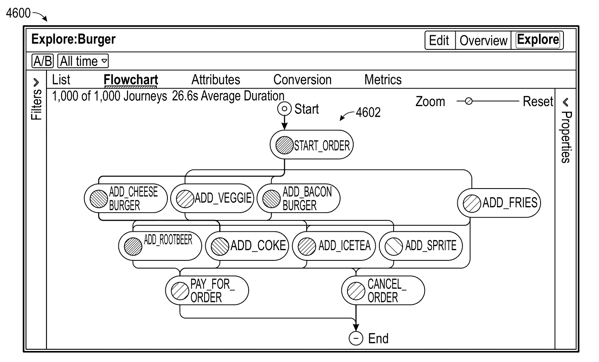| US 11,809,447 B1 | ||
| Collapsing nodes within a journey model | ||
| Jonathan Dillman, San Jose, CA (US); Elizabeth Li, Oakland, CA (US); and Cornelis Jacob Eduard de Vin, Vernon (CA) | ||
| Assigned to Splunk Inc., San Francisco, CA (US) | ||
| Filed by Splunk Inc., San Francisco, CA (US) | ||
| Filed on Apr. 30, 2020, as Appl. No. 16/863,757. | ||
| Int. Cl. G06F 16/26 (2019.01); G06F 16/28 (2019.01) | ||
| CPC G06F 16/26 (2019.01) [G06F 16/283 (2019.01)] | 20 Claims |

|
1. A method, comprising:
causing display of a user interface that displays a plurality of steps of a journey model, wherein individual steps of the journey model correspond to respective actions performable in a computing environment, wherein each of a plurality of journey instances generated from the journey model includes a different ordered set of related events corresponding to instances of the actions being performed, wherein individual ordered sets of related events are built from unordered sets of related events based at least in part on step identifiers, and wherein individual steps in the plurality of steps of the journey model are identified as related to each other based at least in part on a plurality of pivot identifiers; receiving an indication to form an aggregate step representing a subset of the plurality of steps, the subset of the plurality of steps including a first step and a second step, wherein a first journey instance of the plurality of journey instances includes a first step instance of the first step and excludes an instance of the second step, and wherein a second journey instance of the plurality of journey instances includes a second step instance of the second step and excludes an instance of the first step; generating an association between individual steps of the subset of the plurality of steps to form the aggregate step, the aggregate step representing the subset of the plurality of steps; associating the aggregate step with a set of journey instances generated from the journey model, the set of journey instances including the first journey instance and the second journey instance; storing an updated journey model in a data store, the updated journey model including the aggregate step and its association with the set of journey instances; and causing display of a visualization of at least a portion of the updated journey model from the data store, the visualization including the set of journey instances, wherein the visualization includes an object representing an instance of the aggregate step in place of one or more objects representing the first step instance from the first journey instance and the second step instance from the second journey instance, and wherein the object representing the instance of the aggregate step is associated with data from the first step instance and the second step instance. |